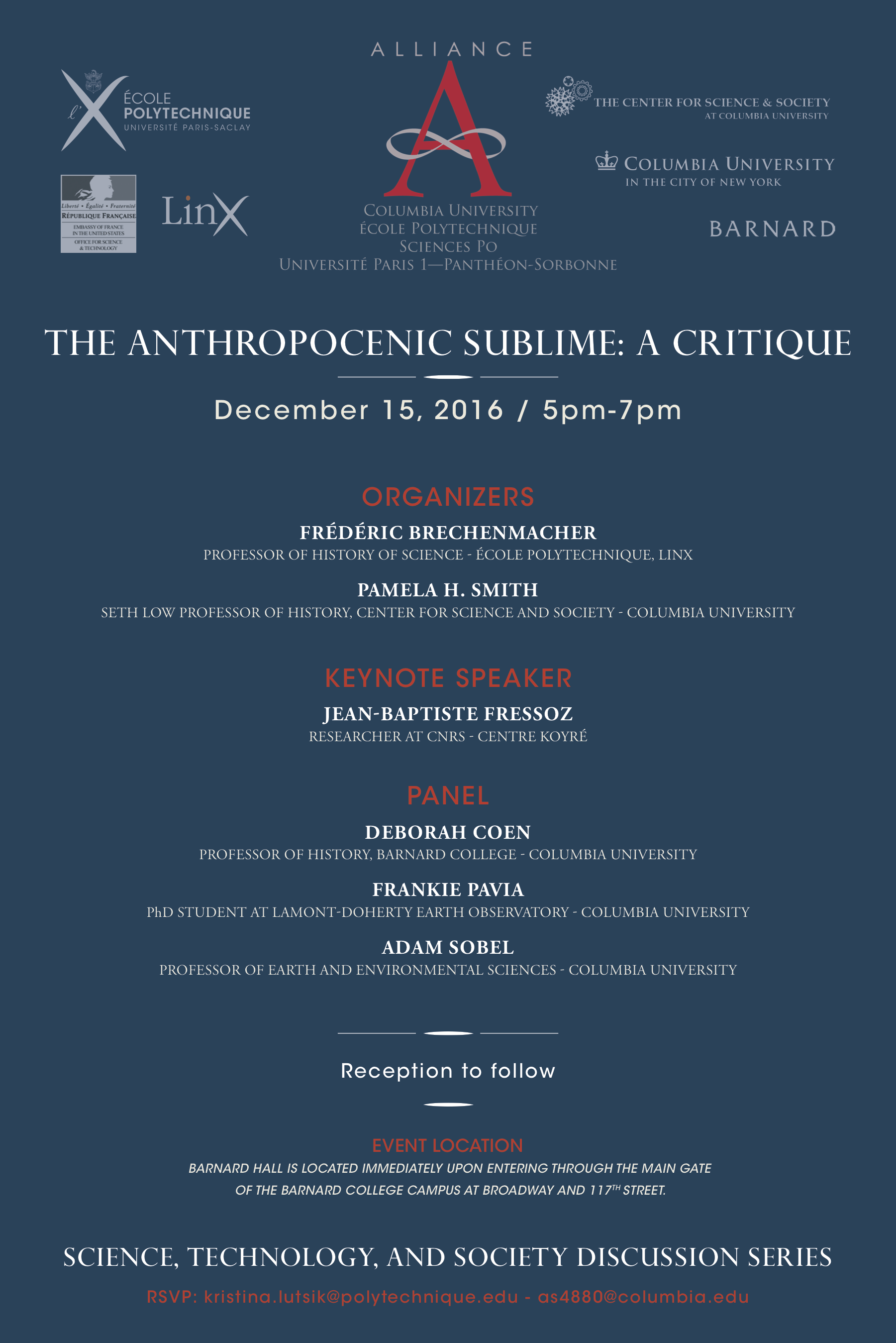Science, Technology and Society Discussion Series : Climate Change and the Anthropocene
A new interdisciplinary series featuring scholars from the École Polytechnique and Columbia University will take place alternately in New York City and Paris. Live streaming video events will be available on the You Tube channel of École polytechnique.
The third lecture, discussion, and reception will be held December 15, 2016 from 5 to 7 pm at Sulzberger Parlor, Barnard College - Columbia University, New York City.
Organizers : Frédéric Brechenmacher (Professor of history of science, LinX, École polytechnique) & Pamela H. Smith (Seth Low Professor of History, Center for Science and Society - Columbia University)
Keynote speaker
Jean-Baptiste Fressoz, Researcher at CNRS - Centre Koyré : "The anthropocenic sublime : a critique"
Roundtable
- Adam Sobel, Professor of Earth and Environmental Sciences, Columbia University
- Frankie Pavia, Ph.D. student at Lamont-Doherty Earth Observatory, Columbia University
- Deborah Coen, Professor of History, Barnard College - Columbia University
Reception to follow
--
Keynote lecture
Jean-Baptiste Fressoz, Researcher at CNRS - Centre Koyré : "The anthropocenic sublime : a critique"
Although staggering, spectacular or grandiloquent, the Anthropocene concept is not a scientific discovery. It does not refer to a recent advance in our understanding of the functioning of the earth system. The Anthropocene is just a stratigraphic division period. Its strength is not conceptual, scientific or even heuristic: it is primarily aesthetic.
The concept of Anthropocene is a brilliant way to rename and summarize some fundamental results of earth system sciences. It captures the idea that the processes that humanity has triggered have such inertia that the earth is leaving the climate regime that prevailed during the Holocene. Unlike the term "environmental crisis" which designates a brief ordeal whose outcome is imminent, the Anthropocene refers to a point of no return. It is a geological bifurcation in the history of the planet Earth, without any foreseeable return to the ‘normal state’ of the Holocene. The strength of the Anthropocene lies precisely in this extraordinary encounter between human history and the history of the earth: two centuries of human activity at most were enough to cause an alteration comparable to the great upheaval at the end of the Mesozoic era 65 million years ago. The Anthropocene discourse plays on this aesthetic of the sudden, of the event, of the bifurcation. This is why the Anthropocene has such an evocative power. What we are experiencing is not a simple "environmental crisis", but a geological manmade revolution. If we do not know exactly what the Anthropocene will mean for us (the computer simulations of the Earth-system are uncertain), one thing is sure: we entered it, with no hope of escape, caught in the chaotic vortex of actions and feedback linking industrial capitalism with the earth system.
But for political ecology, the concept of the Anthropocene is not without problems and shortcomings. One of them is to revive a very peculiar kind of aesthetic, the aesthetic of the sublime, a western and bourgeois aesthetic which had been vilified by Marxists, feminists, subalternists and post-moderns alike.



